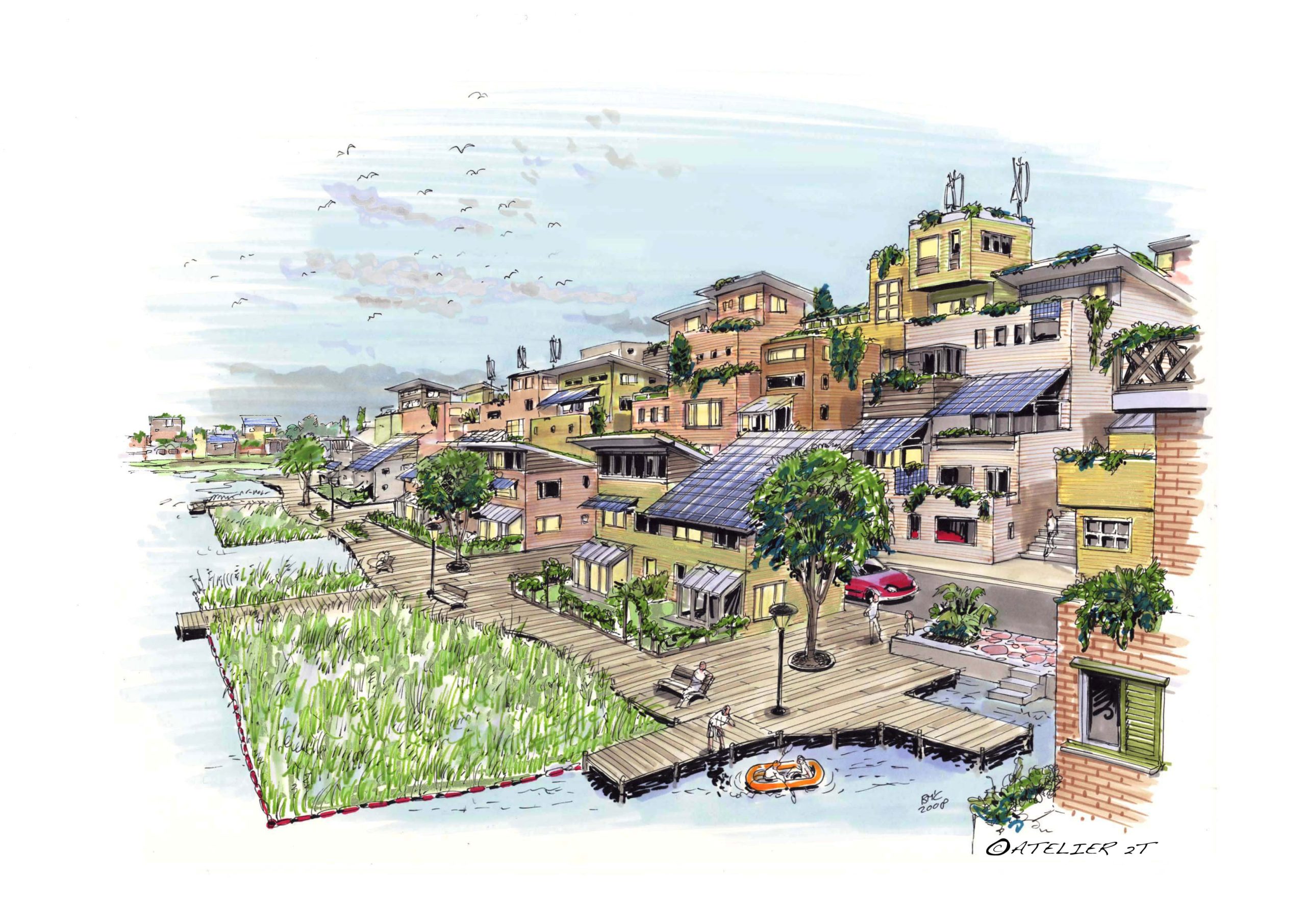During Green Building Week, a team of TU lecturers has launched a brand new book on eco-cities. The book is to help future designers and engineers to green up the urban environment.
Love them or loathe them, cities are here to stay. In 2007 half of the world’s population lived in cities and by 2050 the UN expects seventy percent of all people will be urbanites. The UN Habitat programme foresees the rise of mega- and hypercities with over twenty million inhabitants. One could regard cities as ecological monsters consuming water, energy and materials in huge amounts (forty percent of all materials extracted is used in buildings and structures), and releasing polluted water, greenhouse gases and piles of waste in return.
But then again, cities are also the centres of our economy and generate new economic activities, such as shops, offices and services.
‘In this book we aim to avoid thinking of cities in terms of good or bad,’ writes editor and assistant professor Dr Ellen van Bueren (TPM). ‘Cities are there, and most of them are growing. This is something that we should take as a starting point for our attempts to make them sustainable…. The urban environment holds various keys to a more sustainable planet.’ As examples, she mentions high-density buildings to reduce land use, reusing building materials, making buildings energy-efficient or even energy producing, and providing buildings with green roofs. There is a wealth of opportunities at hand.
The large tome (429 pages) is the outcome of a collective effort of 16 authors from three faculties (Architecture; Civil Engineering and Geosciences; Technology, Policy and Management) and the research institute OTB. Titled ‘Sustainable Urban Environments’, the publication has been written as a textbook for the module ‘Sustainable Urban Environments & Infrastructures’ in the MSc programme Industrial Ecology (TU Delft in cooperation with Leiden University).
“Most similar books just cover energy, water or sanitation topics,” says Van Bueren. “Other books give an overview of best practices, but these tend to be fairly soon outdated.” So, the authors chose a different tack – the systemic approach. “What are the problems you want to address, how do you choose your system boundaries (what to include and what not) and which solutions are there on offer?” says Van Bueren. She is well aware that the urban dynamics is such that future professionals will constantly be confronted by new solutions and new challenges. This new book should help to prepare them.
Ellen van Bueren et.al., ‘Sustainable Urban Environments – an ecosystem approach’, Springer Verlag, 2012.
The book was presented at the first Delft Environment Initiative Lecture, last Wednesday at BK-city.
In verschillende landen heeft internationaliseringsorganisatie Nuffic een Netherlands Education Support Office (NESO) geopend. Zo’n kantoor verzorgt de promotie van het Nederlandse hoger onderwijs, doet marktonderzoek en bemiddelt bij samenwerking tussen onderwijsinstellingen. Ook houdt het NESO contact met buitenlandse alumni.
Maar in China kun je niet zomaar zelf een pand huren en aan de slag gaan. Het is haast onvermijdelijk om samen te werken. De vorige contractpartner van de Nuffic wilde invloed op het plaatsen van Chinese studenten aan Nederlandse universiteiten, waardoor de samenwerking met het NESO stokte. Van een conflict zou geen sprake zijn, zegt het Nuffic nu. Wel van ‘andere denklijnen’.
De sluiting leidde tot enige wrevel onder bestuurders van hogescholen en universiteiten, zoals het Nuffic-blad Transfer meldde. Het leek immers goed te gaan met het aantal Chinese studenten dat naar Nederland kwam.
Maar er is een nieuwe samenwerkingspartner gevonden, meldt Nuffic: de CEAIE. Ook deze partner werkt ‘onder de paraplu’ van het Chinese ministerie van onderwijs. Toch kan de nieuwe NESO volgens afdelingshoofd promotie Han Dommers in alle vrijheid te werk gaan.
De overeenkomst zelf is vertrouwelijk. In het deel dat Nuffic wel wil toesturen, staat dat het NESO en de CEAIE gaan samenwerken bij het verzamelen en analyseren van data over elkaars hoger onderwijs. Ze werken ook samen bij het onderhouden van het alumninetwerk. ‘Waar mogelijk’ geven ze elkaar ook toegang tot elkaars internationale netwerk.
Hierdoor lijken de Chinezen toch een vinger in de pap te hebben. Maar volgens hoogleraar Chinese geschiedenis Barend ter Haar van de Universiteit Leiden klinkt het erger dan het is. “Natuurlijk is CEAIE een overheidsorganisatie. Er zal ook wel iemand van de communistische partij bij betrokken zijn, want die zitten overal. Maar het verschil met de Nuffic is verder niet zo groot: het gaat om het kopen en verkopen van onderwijs. In theorie zou er een dissident kunnen zijn die in het buitenland heeft gestudeerd en dan in China via dat alumninetwerk in de gaten wordt gehouden. Maar in de praktijk zijn zulke dissidenten er niet. Wie zich in China niet op zijn plaats voelt, blijft in het buitenland. Dissidenten zijn meestal mensen die niet weg konden komen.”



Comments are closed.